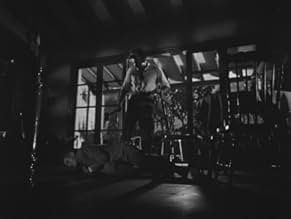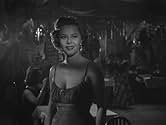IMDb RATING
7.6/10
978
YOUR RATING
A washed up reporter teams up with an immigrant from Hungary to start a fake journalism by correspondence school.A washed up reporter teams up with an immigrant from Hungary to start a fake journalism by correspondence school.A washed up reporter teams up with an immigrant from Hungary to start a fake journalism by correspondence school.
- Director
- Writers
- Stars
- Awards
- 2 wins total
Otto Webber
- Noriega
- (as Otto Weber)
George Hilton
- Hombre en redacción
- (as Jorge Hilton)
- Director
- Writers
- All cast & crew
- Production, box office & more at IMDbPro
Featured reviews
"Los tallos amargos" is a great example of film noir released out of USA. Following the tradition of classic Hollywood (the most brillant time in the history of cinema), this picture tell us the story of a poor journalist who, trying to make easy money, begins to work with an hungarian inmigrant. They start a fake journalism school and soon their pockets are full of dirty money. When the journalist begins to have suspects on your partner, the plot will become most than interesting. A perfect movie, a very good story. A picture that looks like any american film of that time. 9 out of 10.
EXTRA: When the A.F.I. chose the 100 bests cinematography of all time, this argentine movie was in the list among titles like "Citizen Kane" (!)
EXTRA: When the A.F.I. chose the 100 bests cinematography of all time, this argentine movie was in the list among titles like "Citizen Kane" (!)
Very dated movie done --part of it-- as expressionistic 1930s German cinema, part as realistic 1950s European neo realism, all mixed up with a very Argentinian way of interpreting the brief and blunt dialogs throughout the whole movie.
The story is quite interesting. It could have been superbly interesting if the script could have been fully developed going deeply into the main character psychology and motives for his behavior instead of the bumpy way shown here so abruptly from one scene to the next (unless I saw a faulty copy with missing scenes).
Our tortured main character motivations for what he does, as seen in this version, is totally incomprehensible, since he has no real proof to take such a drastic measure to solve the dilemma that tortures his feverish mind.
The photography may be the best asset in this film, done in black and white with a very impressive atmosphere, dark and oppressive almost all the time.
The soundtrack is also very good, following the black mood of the story very precisely and to the point.
But the whole feeling disclosed here, either about the city, its people or our protagonists is nowadays as removed from us as a Christopher Columbus ship could be as incongruous standing next to an atomic submarine.
The story is quite interesting. It could have been superbly interesting if the script could have been fully developed going deeply into the main character psychology and motives for his behavior instead of the bumpy way shown here so abruptly from one scene to the next (unless I saw a faulty copy with missing scenes).
Our tortured main character motivations for what he does, as seen in this version, is totally incomprehensible, since he has no real proof to take such a drastic measure to solve the dilemma that tortures his feverish mind.
The photography may be the best asset in this film, done in black and white with a very impressive atmosphere, dark and oppressive almost all the time.
The soundtrack is also very good, following the black mood of the story very precisely and to the point.
But the whole feeling disclosed here, either about the city, its people or our protagonists is nowadays as removed from us as a Christopher Columbus ship could be as incongruous standing next to an atomic submarine.
I've always searched great but unknown films noirs from outside USA, in England of course, but also France, Italy, Scandinavia, Egypt, South America and especially Argentina.
I just discovered this Argentinian noir movie, and it's a must. A real tough brainstorming in music, cinematography, script, acting. A constant crescendo creepy atmosphere about a man possessed by nasty war II nightmares. Very intelligent use of music by Astor Piazolla , wonderful cinematography by Ricardo Younis (Gregg Tolland's student). And what an ending, never seen such a cynical one. Bravo.
I just discovered this Argentinian noir movie, and it's a must. A real tough brainstorming in music, cinematography, script, acting. A constant crescendo creepy atmosphere about a man possessed by nasty war II nightmares. Very intelligent use of music by Astor Piazolla , wonderful cinematography by Ricardo Younis (Gregg Tolland's student). And what an ending, never seen such a cynical one. Bravo.
There are several twists and turns in this film, so you'll definitely cheat yourself if you read any reviews warning of spoilers.
Thanks to the Film Noir Foundation and UCLA, the restored version aired on TCM's Noir Alley hosted by Eddie Mueller. If you can catch his intro and outro, you'll learn some interesting things, such as the original novel was awarded a very prestigious Argentinian award as was the film itself, the score is by one of Argentina's most celebrated composers, and one of South America's most popular, if not most popular, female actors of the time has a small but important role.
There's all kinds of noir style going on, but there's also echoes of Edgar Allan Poe's use of concise storytelling, paranoia, and the concept of justice as an archetype. The acting is wonderful, and the cinematography is stunning. The musical score is all over the place, but it honestly works.
A must for noir junkies.
Thanks to the Film Noir Foundation and UCLA, the restored version aired on TCM's Noir Alley hosted by Eddie Mueller. If you can catch his intro and outro, you'll learn some interesting things, such as the original novel was awarded a very prestigious Argentinian award as was the film itself, the score is by one of Argentina's most celebrated composers, and one of South America's most popular, if not most popular, female actors of the time has a small but important role.
There's all kinds of noir style going on, but there's also echoes of Edgar Allan Poe's use of concise storytelling, paranoia, and the concept of justice as an archetype. The acting is wonderful, and the cinematography is stunning. The musical score is all over the place, but it honestly works.
A must for noir junkies.
An Argentinian film noir from 1956. Presented a couple of weeks ago as part of TCM's Noir Alley (& whose host Eddie Muller was one of the champions in saving the lost classic) which details a man's greed overwhelming his soul. Down Argentine way, a reporter, played by Carlos Cores, who's barely making ends meet runs into an opportunistic foreigner who works at a bar who sells him on a scheme to fleece readers of their money for a correspondence school scam but after a while the idea of having to separate the wad begins to weigh on Cores so one night he takes a hammer to his partner's head, burying him in his home's garden. As time passes & his partner's son shows up out of the blue (who also begins a romance w/his daughter), the tale takes a turn for the Hitchcockian (& even shades of Edgar Allan Poe as every time Cores looks out his window to his garden, there the dead body lies) w/great camera set-ups & cinematography (according to the notes I've read on the movie, this film's DP taught the peerless Gregg Toland back in the day) & an ending which would shame purported American noirs of the period (the Hays code demanded the bad guy get his). The title's translation is "The Bitter Stems" by the by.
Did you know
- TriviaAs discussed on TCM's Noir Alley by host Eddie Muller in July 2021, a screening of the restored 35mm print of this film was held on behalf of the Film Noir Foundation at the Museum of Modern Art (MoMA) in New York City in February 2016, and shockingly in attendance was 90 year-old Vassili Lambrinos, who, after years of living in various parts of the globe, was living just a few blocks from MoMA. Lambrinos had never seen the film on the big screen nor with an audience before that screening, having seen the film only in an editing room before then.
- Quotes
Andreani: You make him infallible. You have an old passion; the need to obey.
Alfredo Gaspar: Passion to obey?
Andreani: To be a subordinate.
- ConnectionsReferenced in Preserving Memory: Fernando Martín Peña on Argentine Cinema (2024)
Details
- Release date
- Country of origin
- Language
- Also known as
- The Bitter Stems
- Filming locations
- Plaza de Mayo, Buenos Aires, Argentina(Gasper and Jarvis walk in the Plaza de Mayo and look at the Cabildo.)
- Production company
- See more company credits at IMDbPro
- Runtime
- 1h 30m(90 min)
- Color
- Sound mix
- Aspect ratio
- 1.37 : 1
Contribute to this page
Suggest an edit or add missing content




























